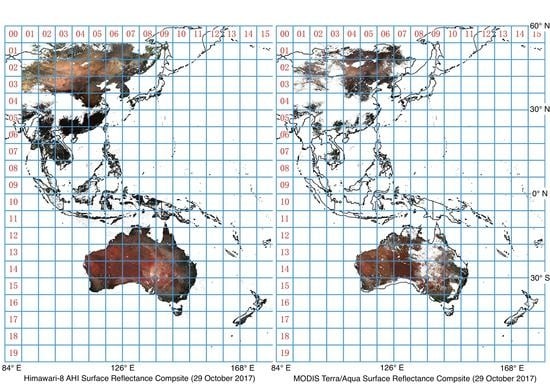First Provisional Land Surface Reflectance Product from Geostationary Satellite Himawari-8 AHI
Abstract
1. Introduction
2. Data
2.1. Preprocessing of Advanced Himawari Imager Data
2.2. The Himawari-8 AHI Surface Reflectance Product
2.3. Himawari-8 AHI Daytime Composite
2.4. Data for Comparison
3. Atmospheric Correction Algorithm
4. Methodology for Comparison
4.1. Ray-Matching Method
4.2. Spectral Band Adjustment
5. Results and Discussion
5.1. Spatial Pattern
5.2. Evaluation of Himawari-8 AHI SR over Vegetation Sites
5.3. Ray-matching Screened Pixels
6. Conclusions
Author Contributions
Funding
Acknowledgments
Conflicts of Interest
References
- Bessho, K.; Date, K.; Hayashi, M.; Ikeda, A.; Imai, T.; Inoue, H.; Kumagai, Y.; Miyakawa, T.; Murata, H.; Ohno, T. An introduction to Himawari-8/9—Japan’s new-generationgeostationary meteorological satellites. J. Meteorol. Soc. Jpn. 2016, 94, 151–183. [Google Scholar] [CrossRef]
- Kurihara, Y.; Murakami, H.; Kachi, M. Sea surface temperature from the new Japa-nese geostationary meteorological Himawari-8 satellite. Geophys. Res. Lett. 2016, 43, 1234–1240. [Google Scholar] [CrossRef]
- JMA (Japan Meteorological Agency). JMA/MSC: Himawari-8/9. Japan Meteorological Agency 2019. Available online: www.data.jma.go.jp/mscweb/en/himawari89 (accessed on 8 May 2019).
- Da, C. Preliminary assessment of the Advanced Himawari Imager (AHI) measurement onboard Himawari-8 geostationary satellite. Remote Sens. Lett. 2015, 6, 637–646. [Google Scholar] [CrossRef]
- Qin, Y.; McVicar, T.R. Spectral band unification and inter-calibration of Himawari AHI with MODIS and VIIRS: Constructing virtual dual-view remote sensors from geostationary and low-Earth-orbiting sensors. Remote Sens. Environ. 2018, 209, 540–550. [Google Scholar] [CrossRef]
- Yu, F.F.; Wu, X.Q. Radiometric inter-calibration between Himawari-8 AHI and SNPP VIIRS for the solar reflective bands. Remote Sens. 2016, 8, 165. [Google Scholar] [CrossRef]
- Liang, X.; Ignatov, A.; Kramar, M.; Yu, F. Preliminary Inter-Comparison between AHI, VIIRS and MODIS Clear-Sky Ocean Radiances for Accurate SST Retrievals. Remote Sens. 2016, 8, 203. [Google Scholar] [CrossRef]
- Lyapustin, A.; Wang, Y. MAIAC—Multi-Angle Implementation of Atmospheric Correction for MODIS: Algorithm Theoretical Basis Document, v1.0, 78. 2008. Available online: https://neptune.gsfc.nasa.gov/bsb/index.php?section=101 (accessed on 22 October 2019).
- Lyapustin, A.; Wang, Y. The time series technique for aerosol retrievals over land from MODIS. In Satellite Aerosol Remote Sensing Over Land; Kokhanovky, A., de Leeuw, G., Eds.; Springer Praxis: Berlin/Heidelberg, Germany, 2009; pp. 69–99. [Google Scholar] [CrossRef]
- Lyapustin, A.; Martonchik, J.; Wang, Y.; Laszlo, I.; Korkin, S. Multi-Angle Implementation of Atmospheric Correction (MAIAC): Part 1. Radiative Transfer Basis and Look-Up Tables. J. Geophys. Res. 2011, 116. [Google Scholar] [CrossRef]
- Lyapustin, A.; Wang, Y.; Laszlo, I.; Kahn, R.; Korkin, S.; Remer, L.; Levy, R.; Reid, J.S. MultiAngle Implementation of Atmospheric Correction (MAIAC): Part 2. Aerosol Algorithm. J. Geophys. Res. 2011, 116. [Google Scholar] [CrossRef]
- Lyapustin, A.; Wang, Y.; Laszlo, I.; Hilker, T.; Hall, F.; Sellers, P.; Tucker, J.; Korkin, S. Multi-Angle Implementation of 5 Atmospheric Correction for MODIS (MAIAC). 3: Atmospheric Correction. Remote Sens. Environ. 2012, 127, 385–393. [Google Scholar] [CrossRef]
- Lyapustin, A.I.; Korkin, S.; Wang, Y.; Quayle, B.; Laszlo, I. Discrimination of biomass burning smoke and clouds in MAIAC algorithm. Atmos. Chem. Phys. 2012, 12, 9679–9686. [Google Scholar] [CrossRef]
- Lyapustin, A.I.; Wang, Y. MCD19A1 MODIS/Terra+Aqua Land Surface BRF Daily L2G Global 500 m and 1 km SIN Grid V006 [Data Set]; NASA EOSDIS Land Processes DAAC: Sioux Falls, SD, USA, 2018. [CrossRef]
- Lyapustin, A.I.; Wang, Y. MCD19A2 MODIS/Terra+Aqua Land Aerosol Optical Depth Daily L2G Global 1 km SIN Grid V006 [Data Set]; NASA EOSDIS Land Processes DAAC: Sioux Falls, SD, USA, 2018. [CrossRef]
- Lyapustin, A.I.; Wang, Y. MCD19A3 MODIS/Terra+Aqua BRDF Model Parameters 8-Day L3 Global 1 km SIN Grid V006 [Data Set]; NASA EOSDIS Land Processes DAAC: Sioux Falls, SD, USA, 2018. [CrossRef]
- Hilker, T.; Lyapustin, A.I.; Tucker, C.J.; Sellers, P.J.; Hall, F.G.; Wang, Y. Remote Sensing of Tropical Ecosystems: Atmospheric Correction and Cloud Masking Matter. Remote Sens. Environ. 2012. [Google Scholar] [CrossRef]
- Hilker, T.; Lyapustin, A.I.; Tucker, C.J.; Hall, F.G.; Myneni, R.B.; Wang, Y.; Bi, J.; Moura, Y.M.; Sellers, P.J. Vegetation dynamics and rainfall sensitivity of the Amazon. Proc. Natl. Acad. Sci. USA 2014, 111, 16041–16046. [Google Scholar] [CrossRef] [PubMed]
- Hilker, T.; Lyapustin, A.I.; Wang, Y.; Hall, F.G.; Tucker, C.J.; Sellers, P.J. On the measurability of change in Amazon vegetation from MODIS. Remote Sens. Environ. 2015, 166, 233–242. [Google Scholar] [CrossRef]
- Martins, V.S.; Lyapustin, A.; de Carvalho, L.A.S.; Barbosa, C.C.F.; Novo, E.M.L.M. Validation of high-resolution MAIAC aerosol product over South America. J. Geophys. Res. Atmos. 2017, 122. [Google Scholar] [CrossRef]
- Superczynski, S.; Kondragunta, S.; Lyapustin, A. Evaluiation of the Multi-Angle Implementation of Atmospheric Correction (MAIAC) Aerosol Algorithm through Intercomparison with VIIRS Aerosol Products and AERONET. J. Geophys. Res. Atmos. 2017, 122, 3005–3022. [Google Scholar] [CrossRef]
- Wanner, W.; Li, X.; Strahler, A.H. On the derivation of kernels for kernel-driven models of bi-directional reflectance. J. Geophys. Res. 1995, 100, 21077–21090. [Google Scholar] [CrossRef]
- Roujean, J.L.; Leroy, M.; Deschamps, P.Y. A bi-directional reflectance model of the Earth’s surface for the correction of remote sensing data. J. Geophys. Res. 1992, 97, 20455–20468. [Google Scholar] [CrossRef]
- Lucht, W.; Schaaf, C.B.; Strahler, A.H. An algorithm for the retrieval of albedo from space using semiempirical BRDF models. IEEE Trans. Geosci. Remote Sens. 2000, 38, 977–998. [Google Scholar] [CrossRef]
- Lyapustin, A.; Wang, Y.; Korkin, S.; Huang, D. MODIS Collection 6 MAIAC Algorithm. Atmos. Meas. Tech. 2018, 11, 5741–5765. [Google Scholar] [CrossRef]
- Ross, J.K. The Radiation Regime and Architecture of Plant Stands; Dr. W. Junk Publishers: Boston, UK, 1981; p. 392. [Google Scholar]
- Li, X.; Strahler, A.H. Geometric-optical bidirectional reflectance modeling of the discrete crown vegetation canopy: Effect of crown shape and mutual shadowing. IEEE Trans. Geosci. Remote Sens. 1992, 30, 276–292. [Google Scholar] [CrossRef]
- Schaaf, C.; Gao, F.; Strahler, A.H.; Lucht, W.; Li, X.; Tsang, T.; Strugnell, N.C.; Zhang, X.; Jin, Y.; Muller, J.P.; et al. First operational BRDF, albedo nadir reflectance products from MODIS. Remote Sens. Environ. 2002, 83, 135–148. [Google Scholar] [CrossRef]
- Doelling, D.; Minnis, P.; Nguyen, L. Calibration comparison between SEVERI, MODIS and GOES data. In Proceedings of the 2004 MSG RAOWorkshop, Salzburg, Austria, 6–10 September 2004. [Google Scholar]
- Hewison, T.J.; Wu, X.; Yu, F.; Tahara, Y.; Hu, X.; Kim, D.; Koenig, M. GSICS Inter-Calibration of Infrared Channels of Geostationary Imagers Using Metop/IASI. IEEE Trans. Geosci. Remote Sens. 2013, 51, 1160–1170. [Google Scholar] [CrossRef]
- Scarino, B.; Doelling, D.; Minnis, P.; Gopalan, A.; Chee, T.; Bhatt, R.; Lukashin, C.; Haney, C. A web-based tool for calculating spectral band difference adjustment factors derived from SCIAMACHY hyper-spectral data. IEEE Trans. Geosci. Remote Sens. 2016, 54, 2529–2542. [Google Scholar] [CrossRef]
- Bovensmann, H.; Burrows, J.P.; Buchwitz, M.; Frerick, J.; Noël, S.; Rozanov, V.V.; Chance, K.V.; Goede, A.P.H. SCIAMACHY: Mission objectives and measurement modes. J. Atmos. Sci. 1999, 56, 127–150. [Google Scholar] [CrossRef]
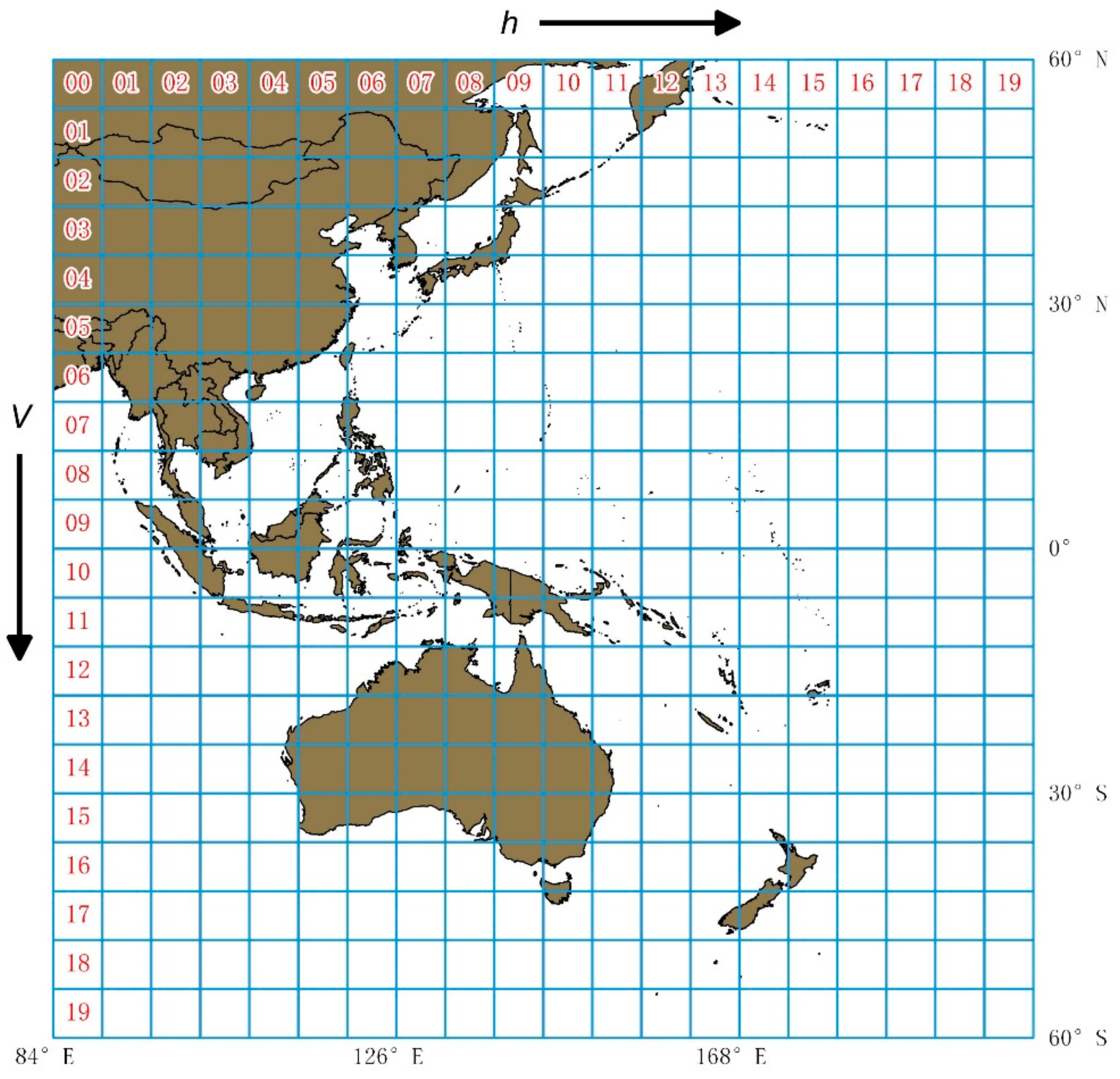
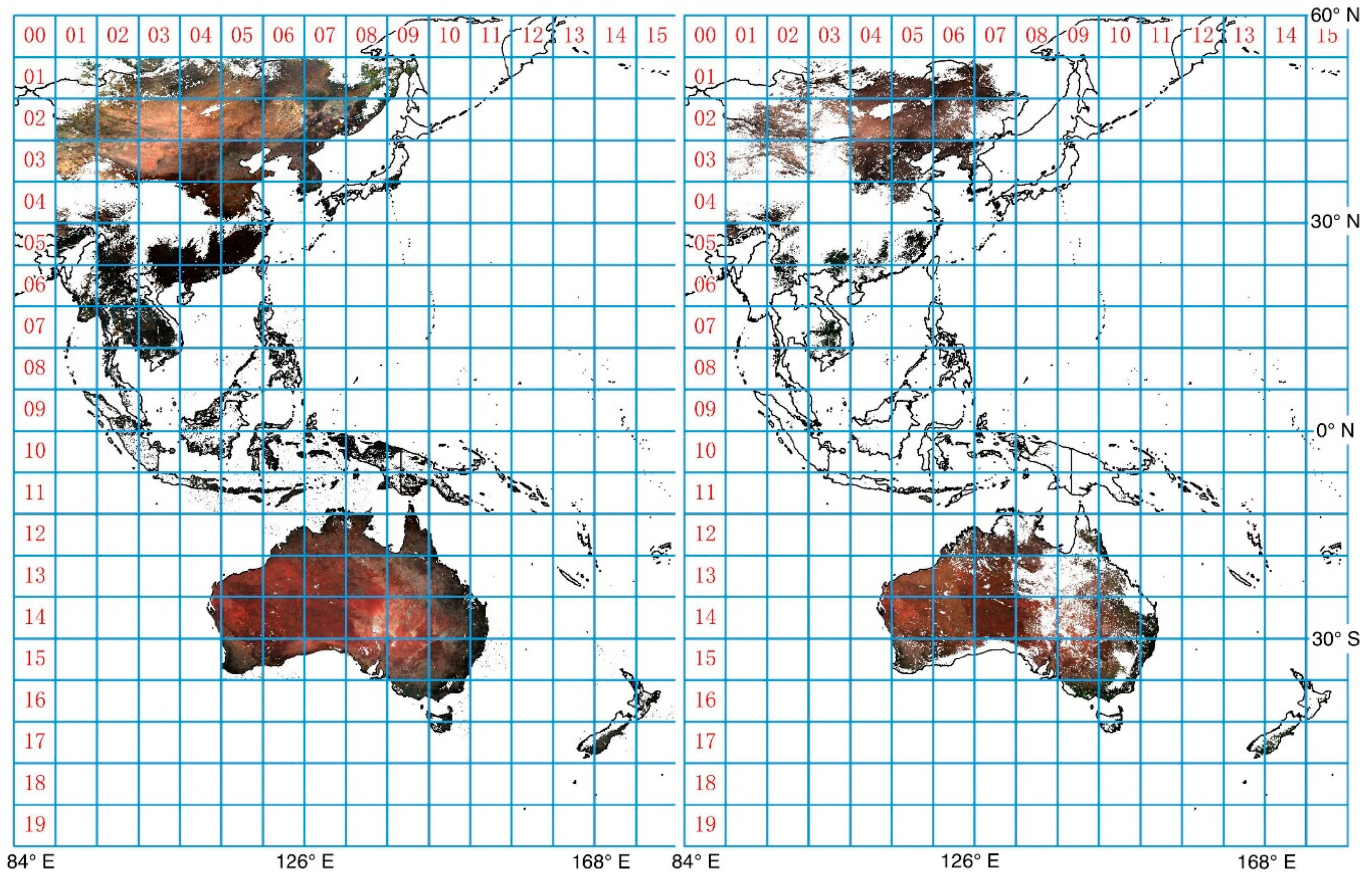
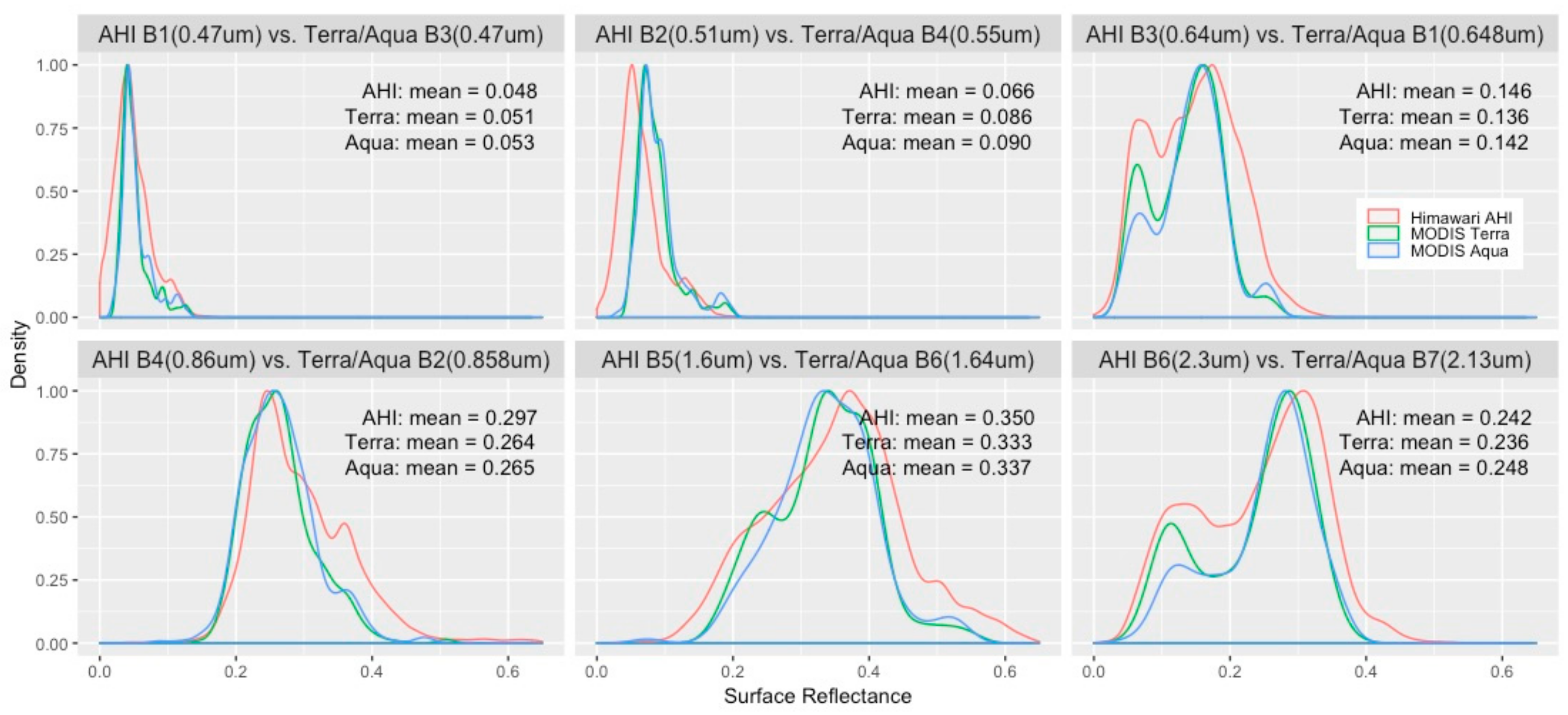
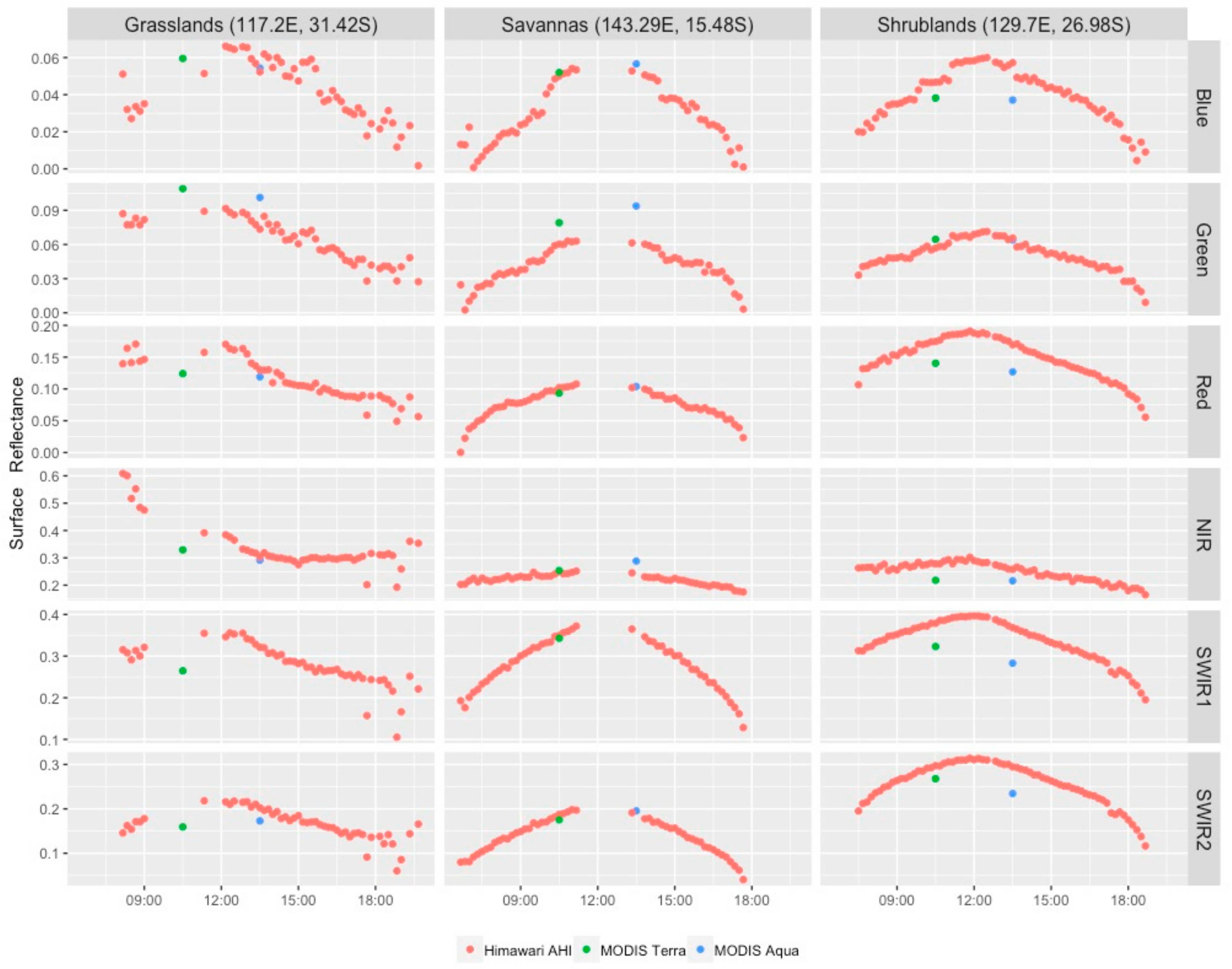

| Product | Cloud/Shadow | Land | AOD Level | Adjacency Mask | Algorithm Initialize Status |
|---|---|---|---|---|---|
| HM08_AHI12 | Clear/no | Yes | Low | Clear | Yes |
| MCD19A1 | Clear/no | Yes | Low | No | - |
| SBAF | AHI | B01 (0.47um) | B02 (0.51um) | B03 (0.64um) | B04 (0.86um) | B05 (1.61um) | B06 (2.3um) | |
|---|---|---|---|---|---|---|---|---|
| MODIS (Terra/Aqua) | B03 (0.47um) | B04 (0.55um) | B01 (0.65um) | B02 (0.86um) | B06 (1.63um) | B07 (2.13um) | ||
| Ray-matching (All-sky) Tropical Land | Terra | SBAF_Slope | 1.001 | 1.037 | 0.995 | 1.004 | 0.941 | 1.0 |
| SBAF_Offset | −1.696e-3 | −3.284e-3 | 8.122e-4 | 1.47e-3 | 1.068e-3 | 0.0 | ||
| Aqua | SBAF_Slope | 1.001 | 1.037 | 0.996 | 1.003 | 0.945 | 1.0 | |
| SBAF_Offset | −1.532e-3 | −3.271e-3 | 8.29e-3 | 7.796e-4 | 9.925e-4 | 0.0 |
| Sensor | Product ID | Revisit Frequency | Grasslands | Savannas | Shrublands |
|---|---|---|---|---|---|
| 117.2E, 31.42S | 143.29E, 15.48S | 129.7E, 26.98S | |||
| AHI | HM08_AHI12 | 10-minute interval | 10,009 | 6813 | 13,778 |
| Terra | MAIACTBRF | daily, 10:30 overpass | 153 | 117 | 241 |
| Aqua | MAIACABRF | daily, 13:30 overpass | 162 | 75 | 219 |
| SR Products | Blue | Green | NIR | Red | SWIR1 | SWIR2 | |
|---|---|---|---|---|---|---|---|
| Morning observations | 0.07 | 0.08 | 0.29 | 0.17 | 0.40 | 0.29 | |
| Coefficient of variation, % | 19.26 | 24.12 | 16.32 | 23.36 | 13.09 | 14.62 | |
| 0.06 | 0.10 | 0.28 | 0.17 | 0.41 | 0.31 | ||
| Coefficient of variation, % | 27.12 | 26.28 | 14.96 | 23.12 | 13.23 | 15.28 | |
| Afternoon observations | 0.06 | 0.07 | 0.25 | 0.13 | 0.33 | 0.24 | |
| Coefficient of variation, % | 11.03 | 14.39 | 11.80 | 17.02 | 11.10 | 13.60 | |
| 0.04 | 0.08 | 0.24 | 0.13 | 0.34 | 0.27 | ||
| Coefficient of variation, % | 17.51 | 18.43 | 12.38 | 18.28 | 11.42 | 13.96 | |
| Blue | Green | NIR | Red | SWIR1 | SWIR2 | |
|---|---|---|---|---|---|---|
| 0.01 | −0.02 | 0.01 | 0.00 | −0.01 | −0.02 | |
| , 100% | 22.56 | −21.97 | 2.69 | 1.33 | −2.15 | −5.98 |
| 0.02 | −0.02 | 0.01 | 0.00 | −0.01 | −0.02 | |
| , 100% | 34.94 | −19.35 | 6.03 | 1.43 | −3.78 | −8.32 |
© 2019 by the authors. Licensee MDPI, Basel, Switzerland. This article is an open access article distributed under the terms and conditions of the Creative Commons Attribution (CC BY) license (http://creativecommons.org/licenses/by/4.0/).
Share and Cite
Li, S.; Wang, W.; Hashimoto, H.; Xiong, J.; Vandal, T.; Yao, J.; Qian, L.; Ichii, K.; Lyapustin, A.; Wang, Y.; et al. First Provisional Land Surface Reflectance Product from Geostationary Satellite Himawari-8 AHI. Remote Sens. 2019, 11, 2990. https://doi.org/10.3390/rs11242990
Li S, Wang W, Hashimoto H, Xiong J, Vandal T, Yao J, Qian L, Ichii K, Lyapustin A, Wang Y, et al. First Provisional Land Surface Reflectance Product from Geostationary Satellite Himawari-8 AHI. Remote Sensing. 2019; 11(24):2990. https://doi.org/10.3390/rs11242990
Chicago/Turabian StyleLi, Shuang, Weile Wang, Hirofumi Hashimoto, Jun Xiong, Thomas Vandal, Jing Yao, Lexiang Qian, Kazuhito Ichii, Alexei Lyapustin, Yujie Wang, and et al. 2019. "First Provisional Land Surface Reflectance Product from Geostationary Satellite Himawari-8 AHI" Remote Sensing 11, no. 24: 2990. https://doi.org/10.3390/rs11242990
APA StyleLi, S., Wang, W., Hashimoto, H., Xiong, J., Vandal, T., Yao, J., Qian, L., Ichii, K., Lyapustin, A., Wang, Y., & Nemani, R. (2019). First Provisional Land Surface Reflectance Product from Geostationary Satellite Himawari-8 AHI. Remote Sensing, 11(24), 2990. https://doi.org/10.3390/rs11242990





